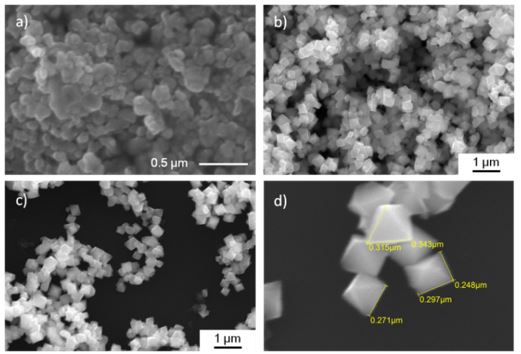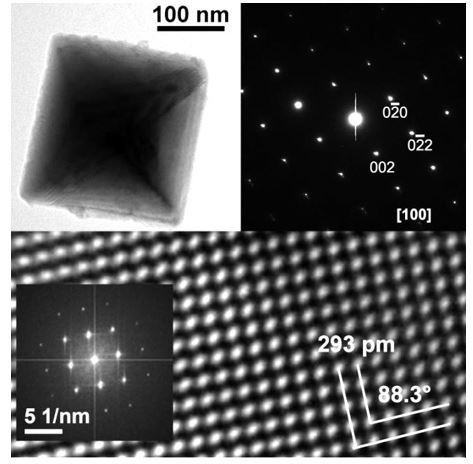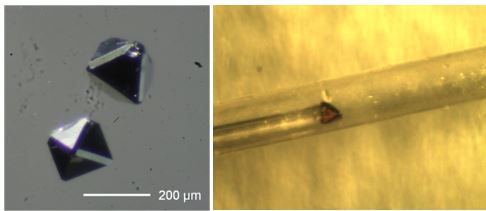Group 14 Chalcogenides
4.3.1.2 Group 14 Chalcogenides
Group IV chalcogenides are known as semiconductors with narrow band gaps, which are of potential interest for technical applications such as photovoltaic devices, for instance solar cells, due to their optical and electrical properties.[1,2] We prepared the whole family of group IV tellurides (GeTe, SnTe, PbTe) using tailor-made donor-stabilized germylenes, stannylenes and plumbylenes of the general type M(OC2H4NMe2)2 (M = Ge, Sn, Pb),[3] which were synthesized by salt metathesis reaction of MCl2 with LiOC2H4NMe2 (fig. 1, right) and which are suitable precursors due to their correct formal oxidation state,[4,5] with Te(SiEt3)2, which can easily be synthesized by reduction of elemental tellurium with LiBHEt3 and further reaction with Et3SiCl (fig. 1, left).[6]
Reactions between as-prepared Ge-, Sn- and Pb-aminoalkoxides and E(SiEt3)2 yielded the desired nanocrystalline particles, which were characterized by SEM, EDX and XRD.
In addition, GeTe nanoparticles with octahedral shape were prepared by reaction of equimolar amounts of GeCl2·dioxane and Te(SiEt3)2 in oleylamine.[7] The correct stoichiometry was found to be essential since GeTe octahedra decorated with elemental Te nanowires were formed in the presence of a slight excess of the Te-precursor. However, the elemental tellurium can easily be removed by washing with TOP.

Scheme 2: Reaction of GeCl2·dioxane and Te(SiEt3)2 in C6D6 and THF-d8.

Figure 2: SEM micrographs of octahedral GeTe microcrystallites as-obtained in DIPB (a) and in oleylamine (b), c), d)) at 160 °C.

Figure 3: TEM bright field image of an GeTe octahedron in [100] orientation and corresponding ED-pattern (top) and HRTEM image and corresponding FT as inset (bottom).
The mechanism of the GeTe formation is strongly influenced by the solvent. The expected elimination of Et3SiCl (dehalosilylation) only occurred in aprotic solvents, whereas Te(SiEt3)2 was found to react with primary and secondary amines with formation of silylamines. Temperature-dependent studies on the reaction in oleylamine showed that crystalline GeTe particles are formed at temperatures higher than 140 °C. XRD, SAED and HRTEM studies proved the formation of rhombohedral GeTe nanoparticles. These findings were confirmed by a single crystal and powder X-ray analysis. The rhombohedral structure modification was found and the structure was solved in the acentric space group R3m.
References
[1] H. S. Im, Y. Myung, K. Park, C. S. Jung, Y. R. Lim, D. M. Jang, J. Park, RSC Adv. 2014, 5, 15695-15701.
[2] P. D. Antunez, J. J. Buckley, R. L. Brutchey, Nanoscale 2011, 3, 2399-2411.
[3] N. N. Zemlyansky, I. V. Borisova, M. G. Kuznetsova, Organometallics 2003, 22, 1675-1681.
[4] R. R. Aysin, V. N. Khrustalev, I. V. Borisova, N. N. Zemlyanskii, A. Y. Smirov, M. S. Nechaev, Russ. Chem Bull., Int. Ed., 2011, 60, 69-80.
[5] M. R. Detty, M. D. Seidler, J. Org. Chem.1982, 47, 1354-1356.
[6] H. Schuhmann, J. Kaufmann, S. Deckert, H.-G. Schmalz, Tetrahedron Letters 2002, 43, 3507-3511.
[7] S. Schulz, S. Heimann, K. Kaiser, O. Prymak, W. Assenmacher, J. T. Brüggemann, B. Mallik, A.-V. Mudring, Inorg. Chem. 2013, 52, 14326.



